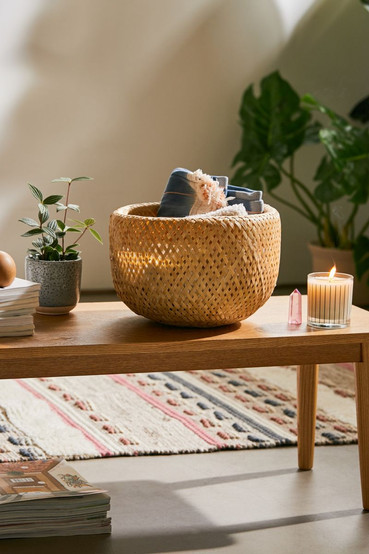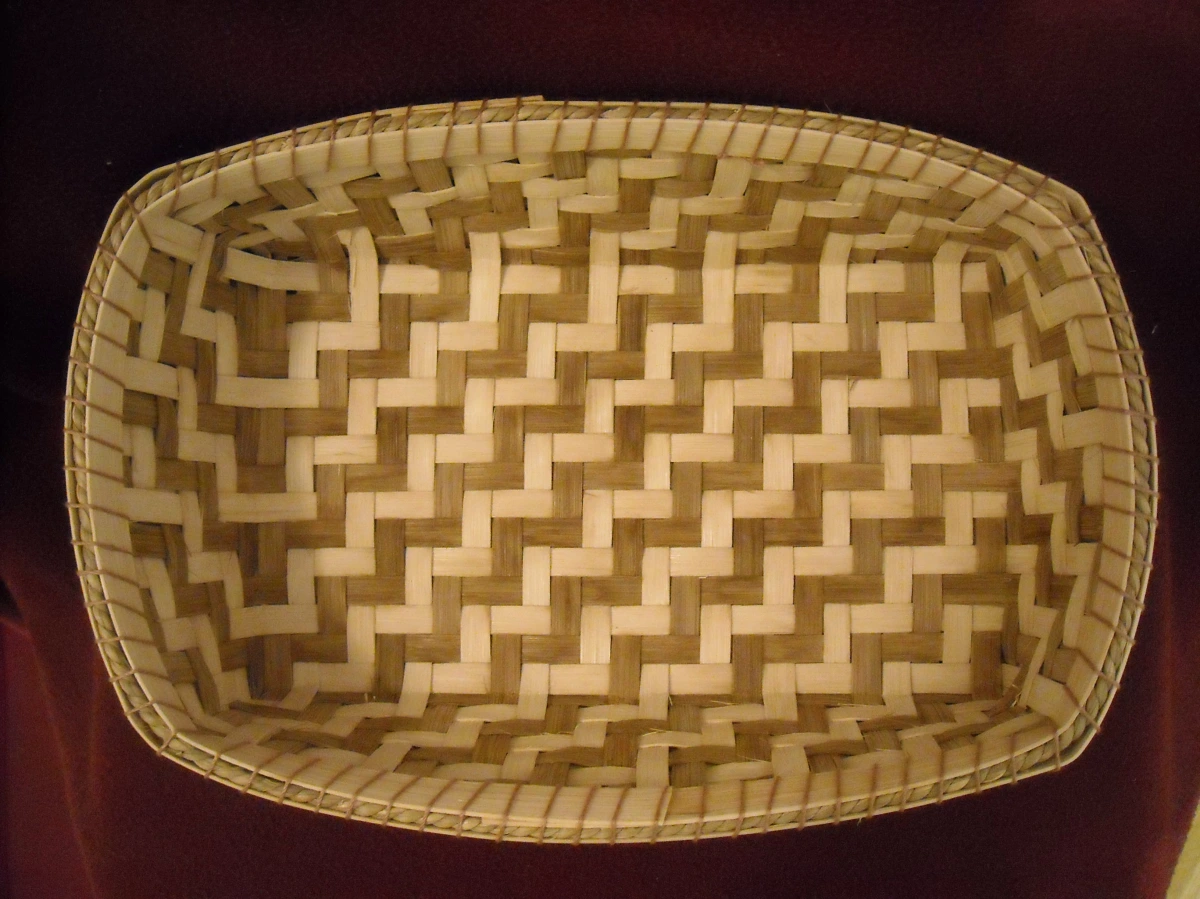7 popular weaving styles for bamboo handicraft products: A guide for handicraft importers
- Thu Uyên Đỗ
- Apr 30
- 6 min read
Updated: Aug 8
Bamboo weaving is a traditional craft that transforms this strong yet flexible material into both functional and decorative pieces.
Often called the “wonder grass,” bamboo stands out for its remarkable versatility, strength, and sustainability. Few natural materials can rival its unique properties, making it ideal for a wide range of handcrafted products and everyday applications.

Although bamboo is very strong and hard in its natural form, when converted into a thin sliver, it can be very flexible owing to its strong fiber properties. This unique quality is what makes bamboo weaving possible, allowing artisans around the world to craft a wide variety of functional and decorative items. Mastering the skill of bamboo weaving has opened up countless opportunities for employment, craftsmanship, and sustainable product development.
Almost all the bamboo species can be used for weaving baskets and mats, but some of them are very hard, and some make very brittle slivers. Thin walls, longer nodes, and smaller diameter bamboo can make better quality slivers for weaving. Mostly freshly harvested thin, thin-walled, long internode-type bamboos are good for weaving.
The reed bamboo varieties are used mostly for making mats and baskets in Kerala and in the Northeast part of India. The baskets made from thin flexible slivers are very sturdy.
Since time immemorial, bamboo has been woven to make various products like carry baskets, storages, containers, mats, fences, bridges, etc. People have been weaving bamboo to make various products according to their requirements.
Basic Terminology for bamboo weaving technique: Warp and Weft
Warp and weft are two basic terms used for bamboo weaving in general.
Warp: is the set of parallel bamboo strips that provide a basis for weaving patterns. In plane bamboo weaving, the warp strips are positioned vertically on the workbench
Weft: is made up of bamboo strips that are inserted perpendicularly under and over the warp to create a design. In plane bamboo weaving the weft strips are positioned horizontally on the workbench.
1. Square Plaiting
Square plaiting is a basic bamboo weaving technique that involves creating balanced horizontal and vertical sections. Due to bamboo's sturdiness, this method often leads to a design with open spaces. Open-weave square-plaiting is typically utilized for the base or walls of bathroom storage baskets.
Suitable Products: Square plaiting is a versatile weave suitable for a wide range of products, including baskets, mats, trays, and coasters.
Production Time: Typically, it is a relatively quick and straightforward weave, making it suitable for mass production.
Cost: Typically, mid-range, as it's a common and relatively simple weaving style.

By changing the width of the horizontal and vertical components, artisans were able to produce a variety of shapes.
2. Clematis Plaiting
Clematis Plaiting is a bamboo weaving technique recognized for its intricate, flower-like pattern. Crafted by tightly compressing six bamboo strips into a hexagonal cell, it creates a detailed, decorative design that stands out in artisanal craftsmanship.
Suitable Products: Due to its elegance and complexity, Clematis Plaiting is often used in premium home décor such as woven lampshades, decorative storage boxes, and wall art.
Production Time: Producing Clematis weaving can be time-consuming due to its intricate nature, making it better suited for artisanal or premium products.
Cost: Because of the high level of artistry and labor involved, products made with Clematis Plaiting generally fall into a higher price range.

3. Double Twill Plaiting
Double Twill Plaiting is a bamboo weaving technique that creates a distinctive diagonal pattern. It’s achieved by allowing bamboo strips in one direction to “float” over multiple strips in the other direction in a consistent, repeating sequence.
Suitable Products: Twill plaiting creates diagonal patterns and is often used for decorative items such as placemats, wall hangings, or handles on bags.
Production Time: It's moderately time-intensive, but not as complex as some other weaves.
Cost: Products using this method typically fall within the mid to mid-high price range, depending on size, strip width, and level of detail.

Craftsmen could make different shapes by changing how the floats were laid out or how long they were, or by changing the width and texture of the strips. This gives artisans creative flexibility in design.
4. Octagonal Plaiting
Octagonal Plaiting is a distinctive bamboo weaving style characterized by double rows of both vertical and horizontal strands, intersected by diagonal strips in both directions to create large, open octagonal spaces. Because of these wide gaps, it is less commonly used for purely functional items, but it excels in adding a decorative, airy look to woven designs.
Suitable Products: This weaving style is often chosen for decorative baskets, especially those with unique or sculptural shapes.
Production Time: Creating octagonal patterns can be moderately time-consuming, particularly for larger or more intricate baskets.
Cost: Generally falls on the higher end due to the precision and craftsmanship required to maintain symmetry and structure.

5. Geometric Weaving
Geometric weaving refers to a bamboo weaving method used to create intricate and precise geometric patterns and designs within a woven textile or object. This technique involves carefully arranging and interlocking weaving elements (such as threads, yarns, or strips of material) in specific ways to form geometric shapes, lines, and patterns. Geometric weaving can be found in various forms of textile art and crafts, including basketry, fabric weaving, and tapestry.
Suitable Products: Geometric weaving is great for products that require intricate, repeating patterns, such as table runners, placemats, or wall art.
Production Time: Can be time-intensive due to the precision needed for consistent shapes and alignment.
Cost: Typically falls into the higher price range, reflecting the craftsmanship and artistry involved.
Diamond Shape

Chevron Pattern

6. Hexagonal Plaiting
Hexagonal plaiting, often referred to as hex weave, is a bamboo weaving technique where strips are interlaced in three directions, one horizontal and two diagonals at 60° angles. This creates a sturdy, open hexagonal pattern that is both functional and visually appealing.
Suitable Products: Commonly used for basket bases or as decorative panels, adding strength and an intricate look to the final piece.
Production Time: Can be time-intensive, especially for larger bases or complex designs.
Cost: Typically mid to mid-high price range, depending on size, complexity, and craftsmanship.

7. Checker Weave Technique
The checker weave, a classic bamboo weaving method, forms a distinctive checkerboard pattern by alternating bamboo strips of varying colors or widths. This timeless design combines simplicity with visual appeal, making it a favorite for decorative and functional pieces alike.
Suitable Products: Checker plaiting creates a visually appealing grid pattern and is often used for basket bases, storage containers, and accent panels to enhance the overall design.
Production Time: It's moderately time-consuming, depending on the size and intricacy of the checkerboard design.
Cost: Generally falls in the mid-range, as it's a popular but not overly complex style.

Combining Multiple Bamboo Weaving Techniques
Bamboo products don’t have to rely on a single weaving style. Many skilled artisans combine multiple techniques in one piece to achieve distinctive textures, patterns, and structural strength. For example:
Twill × Checker Plaiting – combines durability with a balanced, decorative pattern.
Hexagonal × Geometric Weave – creates intricate, artistic bases with unique visual depth.
Square × Octagonal Plaiting – offers bold shapes and an open, airy structure.
Clematis × Twill Plaiting – merges floral elegance with a stable, functional form.
Geometric × Checker Plaiting – blends precision patterns with timeless grid design.
Mixing styles allows for greater creativity and personalization, making each product a functional work of art.

A Quick Guide for Bamboo Handicraft Importers
For importers sourcing bamboo handicrafts, understanding weaving techniques is essential. The weaving style affects not only the visual appeal but also the product’s durability, functionality, and production cost. Here are a few tips:
Know Your Market: Select weaving styles that match your target customer’s tastes, whether they prefer minimalistic patterns or intricate artistry.
Consider Product Use: Indoor bamboo products are the norm, as bamboo is not naturally water-resistant. For outdoor or damp environments, special treatments are required.
Factor in Lead Times: More complex weaving styles require longer production timelines, especially for large orders.
Assess Price Factors: Cost is influenced by weave complexity, bamboo quality, availability of raw materials, craftsmanship, and finishing touches, not just the pattern itself. Seasonal fluctuations and raw material scarcity can drive prices up, so planning ahead is key.
Working closely with experienced sourcing teams ensures you get products that meet both aesthetic and functional expectations, while staying within your budget.

Key Takeaways on Bamboo Weaving
Bamboo weaving is more than just a craft; it’s a sustainable art form that blends tradition, design, and functionality.
Not water-resistant, so primarily suited for indoor décor and accessories.
Each weaving style has its own ideal product applications.
Production time and costs vary widely by pattern complexity.
Mixed weaving techniques offer unique creative possibilities.
This versatility is why bamboo weaving remains a favorite choice for designers, retailers, and consumers who value craftsmanship and eco-friendly materials.
How Rockhill Asia Can Help You
At Rockhill Asia, we work directly with artisan communities and skilled manufacturers across Vietnam and China to develop custom bamboo handicrafts that meet the highest standards of quality and design.
Whether you’re looking for traditional styles, innovative pattern combinations, or sustainable production solutions, we can manage the entire sourcing process, from product development to quality assurance and logistics.
With our on-the-ground teams and deep market knowledge, we ensure you receive bamboo products that are not only beautiful but also consistent in quality, ethically produced, and competitively priced.









































































